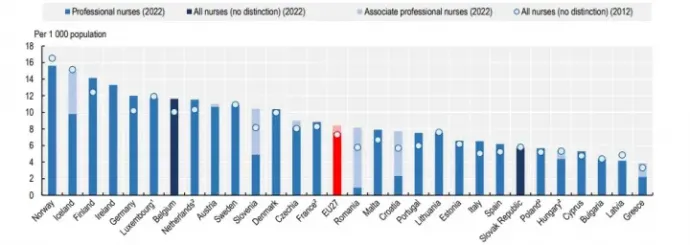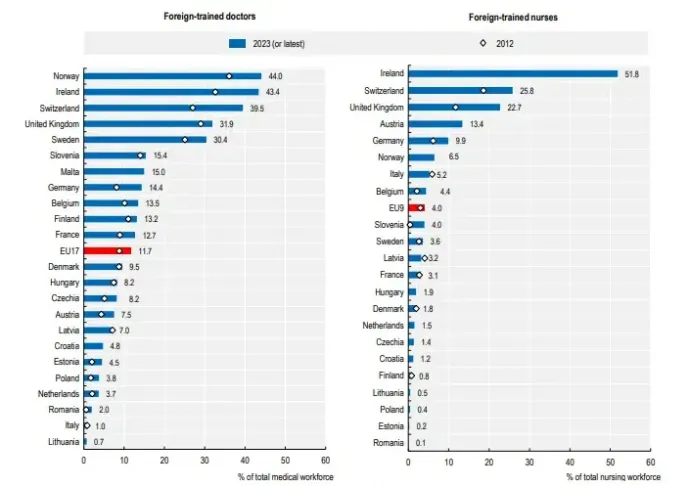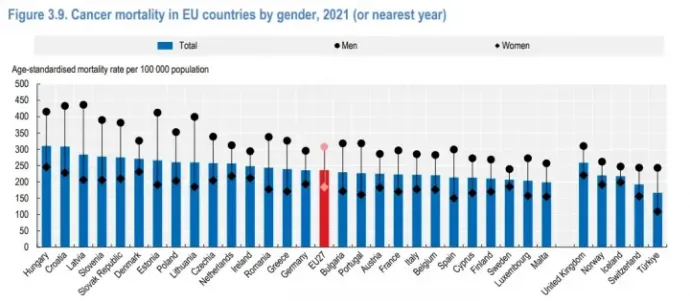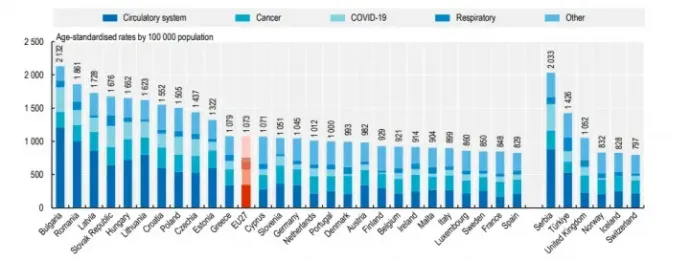OECD report paints dismal picture of Hungarian healthcare and Hungarians' self-destructive lifestyles

According to a report published on Monday by the OECD (Organisation for Economic Cooperation and Development) the Hungarian state spends little on health care, although there are not enough nurses and the number of suicides is relatively high. The study compared health indicators in European countries, including EU member states, candidate countries and countries of the European Economic Area.
In 2022, the state spent €1,867 per person on healthcare in Hungary, compared to the EU average of €3,533. This means that in 2022, 10.4 percent of the GDP was spent on healthcare in the EU, while only 6.2 percent of the GDP was spent on the same in Hungary.
An aging medical workforce
The OECD points out that, in general, urgent action is needed to address the shortage of health workers – and not just in Hungary. In 2022 there were an estimated 1.2 million doctors, nurses and midwives missing from the system across the EU, despite the fact that since 2012, doctors' salaries have increased in real terms in most countries. The OECD study specifically highlights Hungary here, as doctors are now earning hundreds of thousands of forints more than before.
The shortage is mainly due to an aging population, with an increasing percentage of those over 65, who typically have chronic illnesses. In Hungary, 15 percent of the population was over 65 in 2000, and roughly 20 percent in 2023. The proportion of persons aged 65 and over is expected to reach 30 percent by 2050. Life expectancy at birth in the EU reached 81.5 years last year, compared to 76.9 years in Hungary.
The increase of life expectancy at birth does not mean that people are living longer in good health: according to the OECD report, 40 percent of those aged 65 and over in the EU suffer from at least two chronic diseases. Although women live a few years longer than men, they spend most of those years with some form of illness, so healthy life expectancy at birth is almost identical between the sexes.

The second problem is that the medical workforce is also aging. More than a third of all doctors and a quarter of all nurses in the EU are over 55 and are expected to retire in the next few years.
In Hungary, there are 3.5 practising doctors per 1,000 people, compared with 4.2 in the EU. Greece had the lowest number of nurses per capita among EU countries, but Hungary was also at the bottom with fewer than six nurses per one thousand people, compared with an EU average of 8.4. At the same time, young people are less interested in a career in healthcare than before: between 2018 and 2022, more than half of EU countries had fewer people wanting to become nurses than before.
More and more countries resort to employing foreign-trained health professionals to address the labour shortage. More than 40 per cent of doctors working in Norway and Ireland in 2023 graduated abroad. (The four Norwegian universities have limited space and very high admission thresholds, so many of those interested opt for studying abroad to begin with. Hungary also has a large number of Norwegian medical students.) Across the EU, 11.7 per cent of doctors obtained their degree abroad, compared with 8.2 per cent in Hungary, placing us almost in the middle of the list.

The OECD report has found that access to healthcare is very unequal. The reason is that in many countries doctors tend to work in the capital, while fewer take jobs in smaller towns and cities. This is the case, for example, in Hungary, Austria, Croatia, the Czech Republic, Denmark and Greece.
Low turnout for screenings
In Hungary, most deaths are caused by cardiovascular diseases and cancer. This is not surprising, given that our country was at the top of the list for these last year too. Cancer is the second leading cause of death worldwide. However, in 2021, cancer mortality rates in Malta, Luxembourg and Sweden were lower than the EU average, while they were the highest in Hungary, Croatia and Latvia.
According to experts, screenings can play a major role in detecting cancer, but in Hungary, there are still few people taking advantage of this opportunity. As a result, Hungary has the highest number of cancer-related deaths among all European countries compared: there are 452 preventable deaths per 100,000 people under 75, while the EU average is 200. This is not only due to the lack of screening, but also because even if the disease is detected early enough, patients are not always able to benefit from sufficiently rapid and effective treatment.

The study specifically focused on screening women for breast cancer and cervical cancer. While roughly 57 percent of women aged 50-69 in the EU had undergone mammography screening in the two years prior to 2022, less than 30 percent of women in Hungary had done the same. Denmark, Finland and Sweden had the highest screening participation rates, above 80 per cent. The proportion of women in Hungary who had cervical cancer screening was also lower than the EU average. The EU average was 56 per cent, compared to 26 per cent in Hungary.
Only 16 percent of the Hungarian population aged 50-74 years were screened for colorectal cancer, compared to 42 percent in the EU, even though it is one of the most easily detectable and curable cancers.
Hungarians aren't health-conscious enough
In addition to screening, lifestyle is also important in preventing disease. This is why the OECD also looked at risk factors. One of the first of these is smoking. Although the number of teenagers who smoke has been on the decline in most EU countries over the past decade, in 2022, 17 percent of young people – roughly one in six 15-year-olds – said that they have smoked at least one cigarette in the previous month. Almost one in four young people in Hungary said the same, putting us in the top four worst performing countries in this regard.
In the EU, 14 percent of 15-year-olds admitted to having consumed a sugary drink every day in 2022. In Hungary, 20.1 percent of 15-year-olds said the same.

On average, 60 percent of the adult population in the EU consumed fresh vegetables and 61 percent had fresh fruit at least once a day. In Hungary, 41 percent of adults eat fruit every day and only one third eat vegetables every day.
The next risk factor examined by the OECD was obesity. Currently, the number of obese people in the world exceeds the number of those who are starving. Obesity can shorten life expectancy by 3-12 years and the number of years without disease by 25. This places a significant financial burden on both the individuals and society. In Malta 29 percent of men are considered obese versus 25 percent in Hungary.
A sedentary lifestyle can also contribute to obesity. However, Hungary scored particularly well on this indicator. Only 22 percent of 11-year-olds in the EU reached the physical activity level recommended by the WHO, but Finland, Ireland and Hungary scored highest on this, with Italy, Lithuania and France having the lowest numbers.

The report also looked at how people felt about their health. In 2023 in Hungary, 22 percent of 65-year-olds said that their health was "bad or very bad". This figure was nearly 45 percent in 2010.
But we are not doing so well on suicide statistics. Around 47 300 people ended their own lives in the EU in 2021, representing 10.2 deaths per 100 ,000 inhabitants. After Slovenia and Lithuania, Hungary had the third highest percentage of suicides. In 2021, there were 16.8 suicides per 100,000 men and 4.6 per 100,000 women in the EU. In Hungary, there were 25 suicides per 100,000 men and five per 100,000 women.
The coronavirus epidemic was the third leading cause of death in the EU in 2021
Nearly 5.3 million people died in the EU in 2021. This is 100,000 more than in 2020 and 600,000 more than in 2019. According to OECD's research, the coronavirus epidemic is mainly responsible for the increase in deaths, having been the third leading cause of death in the EU in 2021 and accounting for 11 percent of all deaths.
According to the OECD report, in 2021, the number of Covid-related deaths was particularly high in Bulgaria, Poland, Hungary and the Czech Republic. In these countries, there were more than 250 deaths per 100,000 inhabitants. One should treat these figures with caution, however, as it is difficult to compare countries because each country has a different way of keeping track of Covid victims.

The research also looked at the impact of the epidemic on several other points. At the time of the pandemic, 2.4 percent of those aged 65 and over in the EU said they were unable to see their GP. One reason for this was that their GP was not seeing patients during the epidemic. In Hungary, 6.1 percent of the above age group said they had not been able to see their GP.

Relative to its GDP, Hungary spends too little on healthcare
A country's state of health is strongly influenced by how much the government spends on the healthcare sector. In the EU, healthcare expenditure accounted for an average of 15 percent of total government spending in 2022. Healthcare spending has increased in all EU countries.
In Ireland and Germany, the share of public spending on healthcare was around 20 percent, while in Hungary and Greece it was around 10 percent.

This means that Hungary, Croatia, Bulgaria and Romania had the lowest per capita health spending in 2022.
In Hungary, the state spent €1,867 per person on healthcare in 2022, compared to €3,533 in the EU.
As the level of health expenditure also depends on the economic development and size of the country, it is more helpful to compare the figures in relation to the GDP. In 2022, on average, 10.4 percent of the GDP was spent on healthcare, while in Hungary, this figure was 6.2 percent.
For more quick, accurate and impartial news from and about Hungary, subscribe to the Telex English newsletter!